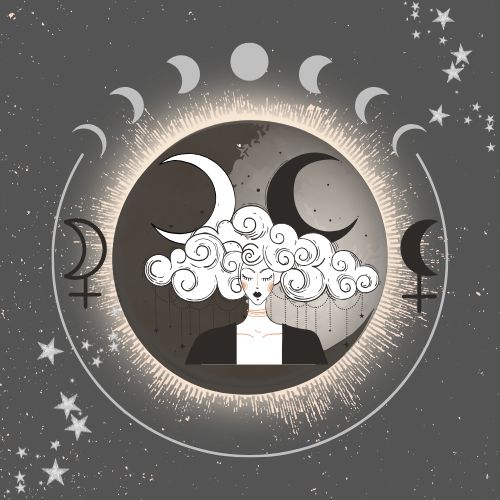
When most people think of the Moon in astrology, they think of the lunar phases or their moon sign. However, thanks to the evolution of modern natal astrology, our understanding of the Moon, much like our understanding of the psyche, is much more complex and nuanced. Here’s a few ways that this has changed the way we interpret lunar phenomena in natal astrology…
LUNAR PHASE
Aside from the monthly moon phases that create emotional and biorhythmic ebbs and flows in our lives, lunar phases have also become a natal astrology personality profiling tool that is used to provide the ‘native’ with more information about their soul evolution journey and core disposition. This trend began in the mid-1930’s when the theosophist, Dane Rudhyar first introduced the idea of using archetypal psychology to interpret personality within the context of the birthchart. In keeping with the ideas of Carl Jung, who associated the Sun and Moon with the conscious and unconscious parts of the psyche respectively, Rudhyar thought that the soli-lunar dance was absolutely central to understanding the key conscious and unconscious drivers of personality.
In his 1967 book, The Lunation Cycle, he took this idea further and began adding the lunar phase a native as born under to his lexicon of chart phenomena worth analysing. In his view, people born at different stages of the waxing and waning spectrum exhibited different traits in terms of their soul maturity and relationship with wisdom or knowledge based on a metaphor or absorbing or reflecting light which mimicked the relationship between the luminaries during the course of a synodic month.

So, for example, he considered people born close to a new moon to be fairly young at heart souls who tend to be quite impulsive and subjective in terms of the way they interpret life or situations. In keeping with the psychological model, Rudhyar felt that New Moon types have a tendency to project themselves onto others more than most, especially their shadow aspects and to view others in more symbolic than ‘realistic’ terms. Similar to natives with most of their personal planets in the lower hemisphere of the birthchart, New Moon types are also said to be focused on self-development and personal growth in terms of their soul path.
By contrast, Rudhyar felt that Full Moon types were more objective and clearer in terms of their ability to perceive other people and situations as they really are, and, in keeping with the opposition aspect, to value relationships of all kinds very highly. In keeping with the notion of natives with the majority of their personal planets in the upper or public hemisphere of the birthchart, Rudhyar believed that waning moon types were more outwardly focused on networks and community than waxing moon types.
Of course, we would now view the notion of subjective vs objective perception he used as overly simplistic, much as the stereotypes of men being more rational and woman being more emotional. Nonetheless, the basis of the metaphor – the receiving/absorbing (self-awareness, learning) and emitting/reflecting (teaching, relating to others) of light – can still be useful and has gradually been updated by modern astrologers so that it is more in keeping with the times.
black moon lilith

Since Rudhyar’s era, the notion of the Jungian Shadow and the theory of psychological projection originally associated with Rudhyar’s New Moon type has been taken one step further by certain astrologers with the introduction of the concept of Black Moon Lilith (BML).
Not to be confused with the asteroid also named Lilith, BML refers to a hypothetical point in the Moon’s orbit (lunar apogee) that is furthest from the Earth, which many astrologers have come to associate with the psychological ‘blind spot’ – what we repress or hide from ourselves, and often project onto others. Like the Pink Floyd song, then this virtual chart point takes the notion of the dark side of the moon/aspects of Rudhyar’s New Moon type one step further – representing not just certain people, but a tendency that we all have – the shadow aspects of ourselves, or our negative sub-conscious drivers, and thus, an aspect of lunar consciousness, or what we may term .
As an astrological symbol, the Black Moon has also come to be associated with the dark aspects of the feminine archetype, which in Jungian terms, we all have (anima in males and the unconscious in females), but often find uncomfortable to handle consciously – the tomb to the Full Moon’s womb, if you like. In astrology, BML is thus closely correlated with psychological growth, especially emotional maturity – something we tend to develop during puberty when hormones are raging and we start to experience, perhaps for the first time, uncontrollable feelings like sexual jealousy, rage or other turbulent emotions which then need to be transmuted or sublimated into something more balanced and healthy – coping strategies we may only learn to master as we enter adulthood. Understanding where we have these seemingly irrational flashpoints or triggers, and learning to integrate or manage them, can lead to Black Moon Lilith’s gift: that of self-empowerment. According to Esoteric Technologies:
The Black Moon’s gift is the opportunity to bring unconscious or self-defeating behaviour into the light of day where it can no longer run amok.
So, for instance, someone with Black Moon Lilith in Sagittarius may not realise that they can become a little too exuberant at times, leading to recklessness or a tendency to take over or offer unsolicited advice, sometimes even bully others. Often, this is because, when they get carried away, folks with this placement are convinced that they know better than their family members or colleagues. As a result, the gift of BML in Sagittarius is to become aware of this, learn to tone it down so as not to keep making poor choices or riding roughshod over others. By learning to give others the freedom to express their own views and passions, the native has the potential to overcome their blind spots and become a very effective teacher or leader.
WHITE MOON SELENA

More recently, though, some astrologers have begun to work with a new lunar point – what some might consider to be BML’s counterpart: White Moon Selena. According to the DeVore Encyclopedia:
Selena is the hypothetical second moon of the Earth. Its distance from Earth is more than 20 times that to the moon and it moves around the earth in a circuit of seven years. Its orbit is a perfect, unperturbed circle. In classical mythology, Selene is the Goddess of the Moon and is often represented as a woman with a crescent moon on her head. The myth talks of her lighting up the night sky as she begins her journey freshly washed in the earth’s oceans.
Astrologers vary on their interpretation of Selena. For many, the White Moon symbolises purity, and the highest aspirations of the soul that may incline us towards things like spirituality, philosophy or altruism. Like The Star card in the tarot, WMS is thought to represent that untainted essence of the soul which remains unsullied by the vagaries of the ego. Unlike other astrological points that might be influenced by external factors, White Moon Selena represents a part of us that remains connected to ‘source’ – the cresent on her head, much like the crown chakra – serving as a bridge to the Higher Self, receiving intuitive messages and guidance which connect us to more elevated states of awareness that can provide us with clues to our spiritual mission and our soul’s noble intentions for this lifetime. By following WMS’s promptings, we are empowered to take steps forward on our soul’s evolutionary journey, whilst also becoming more in tune with any natural gifts or abilities we may have that can potentially assist humanity or light the way for others.
By way of example, someone with White Moon Selena in Gemini might be a really effective communicator – someone articulate with a love of language who is also a natural networker. They may have a very pleasant voice or a magical ability to phrase things or choose metaphors that are incredibly erudite and perfectly illustrative. People with this placement can be a real breath of fresh air and may be drawn to fields where they can put these gifts to good use, not merely for themselves but to benefit their community, such as public service, teaching or politics.
Wondering where your lunar trilogy placements are? Well, there’s no need to go searching for a Black Moon Lilith or White Selena calculator – I have now begun to include all three indicators into a new page in all my natal astrology written reports called ‘Moon Modes’ with the aim of helping you get a deeper understanding of your lunar gifts and/or blind spots. I also now include a dedicated section on Black Moon Lilith and its effect on your attachment style in my Kindred Spirits Reports. Check them out if you’re interested – there are quite a few special offers active in the Astrologysphere Shop that you can potentially benefit from, between now and the new year.

